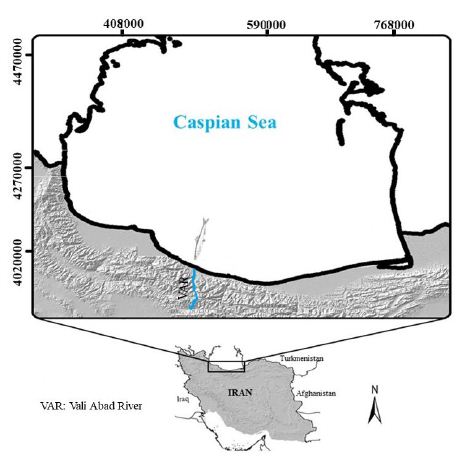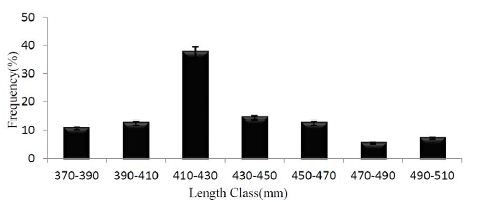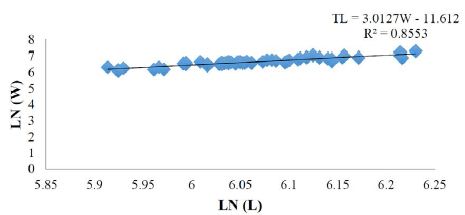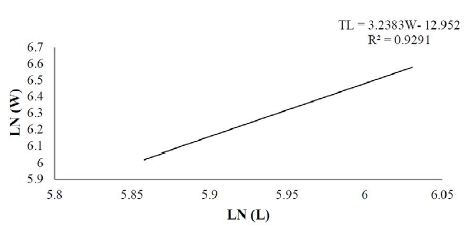DOI: 10.31038/AFS.2022422
Abstract
This study was conducted to determine the age and growth of Caspian kutum (Rutilus frisii kutum) in Vali Abad River, Mazandaran Province during 2020-2021. In this experiment, 100 fish were caught using a gill net with a mesh size of 5 mm. Kutum age was determined based on the scales. The results showed that the maximum age of males and females of the study area was 5+ and 6+ years, respectively. In males, the fish were 3+ years old (57.14%) and for females, 4+ years old (35.71%) had the highest frequency among age groups. The highest instantaneous growth rate was recorded in both sexes between 2+ and 3+ years, and this parameter has decreased significantly with increasing age. The relationship between total length and weight was calculated for males TL=3.23W-12.95 (R2=0.92, n=50) and for females TL=3.01W-11.61 (R2=0.85, n=50). Based on Powell’s formula, the growth pattern was isometric for both sexes.
Keywords
Age and growth, Caspian Sea, Mazandaran, Rutilus frisii kutum, Vali Abad River
Introduction
Age is one of the most important biological aspects of fish, and the lack of accurate information on the age of many fish species leads to inappropriate management policies [1]. Growth phenomenon is also one of the most key biological aspects of fish in the population, which exhibits the type of adaptation to environmental conditions [2]. The kutum in the Caspian Sea (Rutilus frisii kutum) belong to the Cyprinidae family [3]. This species can be found all along the southern coast of the Caspian Sea from the river Atrak to the Kora. Vali Abad River, one of the tributaries of Cheshmeh Kileh River, flows in the southeast of Tonekabon city center. It is rain-fed and flows from west to east. The river has a length of 14 km, an average bed slope of 0.7% and flows in bicarbonate and bicarbonate sulfate areas [4]. Many kutums migrate to the Shiroud, Vali Abad, Hawiq, Lemir, Anzali, Sefidrood, Tajan, Babolrood and Gorganrood Rivers to reproduce in the coasts of Iran [5]. Terms of catch and extraction, kutums is one of the most valuable fisheries in the Caspian Sea and contributes more than half of the total catch of bony fish [6]. Overall, 90% of its resources comes from Iran [7]. This fish with its high economic value in the southern shores of the Caspian Sea which depends on conservation [8].
There are numerous studies on the age structure and growth of kutum in the southern part of the Caspian Sea [6,9-14]. In view of the vital role of kutum, especially for northern Iran, and the policy pursued by the Iranian Fisheries Department to conserve this species by artificial reproduction, which takes place every year at the mouths of rivers, it would seem that the Caspian kutum must be examined annually. The objective of this study was to determine the age and growth parameters of the Caspian kutum in the Vali Abad River to take more effective management measures.
Materials and Methods
The study was conducted in 2020-2021 (from March 11 to May 4) on Vali Abad River in Mazandaran province (Figure 1).

Figure 1: Map of the Iranian waters of the Caspian Sea, showing the fishing area
In this study, 100 fish samples (50 males, 50 females) were caught using a gill net with a 5 mm mesh size. At the same time, these fish were caught for reproduction, to be released and restore reservoirs. Total body weight was measured using a digital scale with 15 gr accuracy, and total body length was measured using a biometric board with 1 mm accuracy. To determine age, six scales were removed from the beginning of the dorsal fin and lateral line. They were first washed with a soap solution between two fingers to remove the epidermal layer. The scales were then placed dry between two slides and fixed with adhesive tape [15]. The annual rings were determined under a mirrored loop with a magnification of 10 to 40. The average length, weight, and composition of the different age groups as well as the length classes frequencies were evaluated in Excel.
Length-weight Relationship
The relationship between length and weight in fish was an exponential relationship of ![]() that was converted to a linear relationship by logarithm
that was converted to a linear relationship by logarithm ![]() . Where W: weight of the fish (gr), L: total length (mm), a: constant coefficient, b: the slope of the curve resulting from length and weight [16].
. Where W: weight of the fish (gr), L: total length (mm), a: constant coefficient, b: the slope of the curve resulting from length and weight [16].
Condition Factor
The condition factor is calculated by from the Whitely equation [17]. ![]() where K: Condition factor, W: Total body weight (gr), L: Total body length (mm).
where K: Condition factor, W: Total body weight (gr), L: Total body length (mm).
Instantaneous Growth Rate
Instantaneous growth rate is calculated by the presented formula [17]. ![]() Where G is instantaneous growth coefficient, lnW (t) is normal logarithm of (t) yearly weight (gr), lnW (t + 1) is normal logarithm of weight of (t + 1) (gr), Δt is difference between (t + 1) age and yearly (t).
Where G is instantaneous growth coefficient, lnW (t) is normal logarithm of (t) yearly weight (gr), lnW (t + 1) is normal logarithm of weight of (t + 1) (gr), Δt is difference between (t + 1) age and yearly (t).
Growth Pattern
Growth pattern was determined by Pauli test [18] including: ![]() Where SdlnL is standard deviation of the natural logarithm of length (mm), SdlnW is standard deviation of the natural logarithm of weight (g), b is slope of the curve resulting from the relationship between length and weight, r2 is regression coefficient between length and weight, and n is the number of samples.
Where SdlnL is standard deviation of the natural logarithm of length (mm), SdlnW is standard deviation of the natural logarithm of weight (g), b is slope of the curve resulting from the relationship between length and weight, r2 is regression coefficient between length and weight, and n is the number of samples.
The graphs and calculations were made with the programs Excel (2019) and SPSS (26) software.
Results
Average Length-Weight, and Frequency Percentage at Different Ages
The results showed that the length of females and males ranged from 372.82 ± 2.13 to 447.28 ± 8.99 mm and from 369.90 ± 5.18 to 403.00 ± 5.70 mm, respectively. Their weight varied between 517.57 ± 5.27 and 894.19 ± 81.26 g, and between 486.41 ± 25.30 and 615.42 ± 42.00 g for the female and male fish, respectively (Table 1). Five and four age classes were observed between females and males, respectively. Females had the highest frequency in age group 4+ (35.71%) and the lowest frequency in age group 6+ (3.57%). While for males, the highest and lowest frequencies in age groups were recorded in 3+ (57.14%) and 5+ (5.72%) (Figure 2).
Table 1: Average length (mm), weight (gr) in different age groups of female and male kutum in the Vali Abad River
|
Age groups |
||||||
| Sex |
2+ |
3+ | 4+ | 5+ |
6+ |
|
| Female | TL(mm) |
372.82±2.13 |
412.17±16.83 | 430.30±5.96 | 438.32±14.71 |
447.28±8.99 |
| W(gr) |
517.57±5.27 |
684.10±33.90 | 819.45±67.18 | 842.24±21.38 |
894.19±81.26 |
|
| Male | Tl(mm) |
369.90±5.18 |
383.19±8.82 | 387.16±7.39 | 403.00±5.70 |
— |
| W(gr) |
486.41±25.30 |
549.99±44.18 | 571.94±38.10 | 615.42±42.00 |
— |

Figure 2: Kutum age frequency in the Vali Abad River
Frequency of Length Classes
The most frequent length classes were recorded for female 430-410 mm (37.5%) (Figure 3) and male 410-400 mm (28.57%) (Figure 4).

Figure 3: Percentage of length frequency of female kutum in the Vali Abad River

Figure 4: Percentage of length frequency of male kutum in the Vali Abad River
Length-Weight Relationship
Relationship between length and weight in female fish TL=3.01W-11.61 (R2=0.85, n=50) (Figure 5), male fish TL=3.23W-12.95 (R2=0.92, n=50) (Figure 6) and total fish TL=3.02W-11.69 (R2=0.91, n=100) (Figure 7). Computational t was obtained for females, males, and total fish at 0.96, 1.39, and 1.04, respectively, which were compared with the t-table with n-2 degrees of freedom at the level 0.95, It is smaller than the t-table, so the growth pattern of all three groups is isometric.

Figure 5: Length-weight relationship of female kutum in the Vali Abad River

Figure 6: Length-weight relationship of male kutum in the Vali Abad River

Figure 7: Length-weight relationship of total kutum in the Vali Abad River
Instantaneous Growth Rate (G)
The highest instantaneous growth rate was attributed to the two age groups 2+ to 3+ compared with other age groups (Table 2).
Table 2: Instantaneous growth coefficient (G) in different age groups of kutum in the Vali Abad River
|
Age |
2+ – 3+ | 3+ – 4+ | 4+ – 5+ |
5+ – 6+ |
| Female |
0.279 |
0.180 | 0.028 | 0.06 |
| Male |
0.122 |
0.039 | 0.074 | — |
| Total |
0.206 |
0.119 | 0.058 |
0.06 |
Condition Factor (K)
The results of the six groups age condition factor in females, males, and total fish showed that female fish in age group 2+ (1.065), male fish in age group 3+ (0.985), and total fish in age group 4+ (1.004) were condition factor better than other groups (Table 3).
Table 3: Condition coefficient (K) in different ages of kutum in the Vali Abad River
|
Age |
2+ | 3+ | 4+ | 5+ |
6+ |
| Female |
1.065 |
0.977 | 0.996 | 0.746 | 1.001 |
| Male |
0.963 |
0.985 | 0.971 | 0.936 |
— |
| Total |
0.977 |
0.981 | 1.004 | 0.996 |
1.001 |
Discussion
Population structure influences the number of age groups and maximum observed ages between populations [19]. The maximum age observed in this study was 5+ for male fish and 6+ for female fish. According to Afraei Bandpei et al. (2010), the maximum age for males and females in Shirood Tonekabon River was 7+ and 9+, respectively [13]. Gorjian Arabi et al. (2012) found that the observed maximum age for males was 4+ and for females was 5+ in Tajan River in Sari [12].
With respect to the average length and weight in the study area among the age groups, in male fish, length group 3+ (383.88 ± 19.52 mm) and weight group 4+ (571 ± 100.94 g) showed the highest standard deviation, while in female fish, the same parameter was observed in length and weight groups 5+ (438.32 ± 14.71 mm) and (842.246 ± 21.38 g), respectively. The high standard deviation in each of the above length and weight groups at different ages indicates the heterogeneity in length or weight at these ages, which may be attributed to the artificial reproduction of kutum in this river. Afraei Bandpei et al. (2010) studied fork length and weight of females of age classes 1+ to 9+ and reported that the highest fork length and weight were assigned to age class 9+ (580 mm and 2450 g) [13]. In addition, they examined males of age groups 1+ to 7+ and reported that age group 7+ (500 mm and 1689 g) had the highest values of the corresponding traits.
As for length frequency, the greatest in males was 416-400 mm (28.57%), while females’ length class in this river was 430-410 mm (37.5%). As for the growth pattern, the females (t=0.96), males (t=1.39) and total fish (t=1.04) were isometric. Growth patterns may vary depending on some biological and non-biological factors such as water temperature, food availability, and habitat type [20]. Isometric growth may be explained by seasonal variation and some biological parameters such as sex, maturity age, food quantity, etc. [15]. Similarly, Afraei Bandpei et al. (2010) found an isometric growth pattern for both sexes [13]. In contrast, Golshahi and Moradnejad (2009) claimed that growth pattern is allometric in both males and females [14]. Moreover, Forouhar Vajargah et al. (2020) demonstrated a negative allometric growth pattern for males and females is isometric [10]. The condition factor in male and female fish, as well as total fish was close to one. This factor is an indicator of the proportionality or relative condition factor of fish, that its increasing value indicates higher fish weight [17]. Farabi et al. (2008) stated the condition factor for female and male whitefish breeders in Mazandaran province as 1.42 and 1.38 respectively [21]. Forouhar Vajargah et al. (2020) determined condition coefficients for male, female and total fish of 1.10, 1.01 and 1.07, respectively [10]. Generally, weight of fish and other animals increases under the influence of body length, so it can be assumed that height and growth are related in a species. As for the correlation between length and weight, male fish (r2=0.92) showed a higher correlation than female fish (r2=0.85). Moreover, Golshahi and Moradnejad (2009) reported correlation coefficients for male fish (r2=0.976) and for female fish (r2=0.921) [14]. Regarding the instantaneous growth coefficient, the 3+ to 2+ age groups were the first age class, showed the highest instantaneous growth coefficient. Field and laboratory studies have shown that the change in growth rate is more dependent on the frequency and accessibility of food. [22] studied the instantaneous growth rate between age classes of both sexes and concluded that this coefficient does not follow the general rule of decreasing with age, which is consistent with our results.
Conclusion
Overall, the nutritional value of Caspian whitefish makes it necessary to take measures to prevent overfishing, especially during the reproductive season, in addition to artificial reproduction, to protect the region’s reserves and allow continuous fishing. Furthermore, proper management of dams on rivers leading to the Caspian Sea and water flow during the reproductive season in estuaries can allow migratory fish from the sea to enter the rivers to spawn, so that nature can find its way.
References
- Gelsleichter J, Piercy A, Musick JA (1998) Evaluation of copper, iron and lead substitution techniques in elasmobranch age determination. Journal of Fish Biology 53: 465-470.
- Mann RH, Growth and Production. In I.J (1991) Winfield and J.S. Nelson (EDS), Cyprinid Fishes. Systematic, Biology and Exploitation. Chapman and Hall, London, 446-481.
- Vossoughi GH, Mostajeer B (2006) Freshwater Fish. Tehran University Press, 317.
- National Geographical Organization of IRAN (2003) The gazetteer of rivers in the I.R of Iran, Caspian Sea watershed (Volume II). National Geographical Organization Publication, Tehran, 312.
- Naderi M, Abdoli A (2004) Fish Species Atlas of South Caspian Sea Basin (Iranian Waters). Iranian Fisheries Research Organization, Teheran, 2004, 112.
- Abdolmaleki SH, Hashemi A, Nahror R (2007) Fishing status and population structure of Caspian kutum, Rutilus frisii kutum in the Iranian Coastal Waters of Caspian Sea. Journal of Marine Science and Technology 6: 51-62.
- Razavi Sayad B. Kutum fish (1995) Iranian Fisheries Research Organization (IFRO). Tehran, 165.
- Abdoli A, Naderi M (2009) Biodiversity of Fishes of the Southern Basin of the Caspian Sea. Abzian Scientific Publication, Tehran, 237.
- Shahifar R, Patimar R, Fazli H, Raeisi H, Gholizadeh M, et al. (2020) Growth and mortality parameters of Caspian kutum, Rutilus kutum, in Southern Caspian Sea. International Journal of Aquatic Biology 8: 56-65.
- Forouhar Vajargah M, Sattari M, Imanpur J, Bibak M (2020) Length-weight relationship and some growth parameters of Rutilus kutum (Kaminski 1901) in the South Caspian Sea. Experimental animal Biology 9: 11-20.
- Forouhar Vajargah M, Sattari M, Imanpur J, Bibak M (2020) Length-weight, length-length relationships and condition factor of Rutilus kutum (Actinopterygii: Cyprinidae) from the southern Caspian Sea, Iran. Journal of Animal Diversity 2: 56-61.
- Gojian Arabi MH, Sedaghat S, Hoseini SA, Fakhri A (2012) Age and Growth of Kutum, Rutilus frisii kutum (Kamenskii 1901) in Tajan River (Southern Caspian Sea to Iran). Global Veterinaria 9: 211-214.
- Afraei Bandpei MA, Mansor M, Abdolmalaki S, Keymaram F, Isa MM, et al. (2012) Age and growth of kutum (Rutilus frisii kutum, Kamensky, 1901) in Southern Caspian Sea. International Aquatic Research 2: 25-33.
- Golshahi K, Moradnezhad HR (2009) Investigation of migration and propagation of Rutilus frisii kutum in Goharbaran River (Mazandaran province). Journal of Fisheries 2: 78-88.
- Bagenal TB, Tesch FW (1978) Eggs and early life history. In; Bagenal. T.B. Methods for assessment of fish production in freshwater. 3rd edition. Blackwell scientific publication, London 165-201.
- Wooton RJ. Ecology of Teieost fishes (1990) Chapman and Hall Ltd, 1990, 404.
- Biswas SP (1993) Manual of Methods in Fish Biology. South Asian Publication Ltd. New Delhi, India 157.
- Froese R, Binohlan C (2000) Empirical relationships to estimate asymptotic length, length at first maturity and length at maximum yield per recruit in fishes, with a simple method to evaluate length frequency data. Journal of fish biology 56: 758-773.
- Goldspink CR (1979) The population density, growth rate and production of roach Rutilus rutilus (L.) in Tjeukemeer, The Netherlands. Journal of Fish Biology 15: 473-498.
- Wootton RJ (1992) Fish ecology. Blackwell, Glasgow 203.
- Patimar R, Hosseini SH, Azimi A, Hajidun HA (2007) Age structure of migrant Kutum (Rutilus frisii kutum kamensky, 1901) into the Tonekabon River. Journal of Fisheries 1: 9-18.
- Farabi SMV, Khoshbavar Rostami H, Ghaneei Tehrani M, Ghiasi M, Azari A, et al. (2004) The investigation of status brood stocks and releasing fingerlings of Rutilus frisii kutum (Kaminski, 1901) in the South of Caspian Sea (Mazandaran province, 2004). Journal of Pajouhesh Sazandegi 74: 156-166.